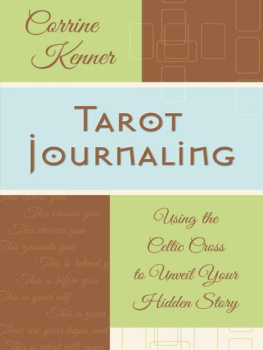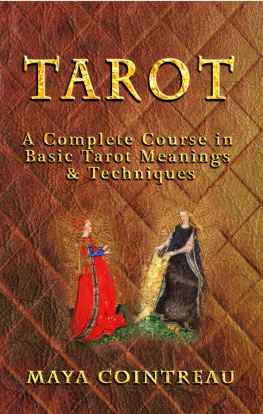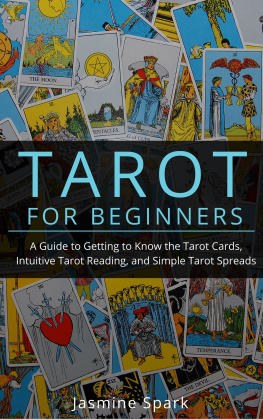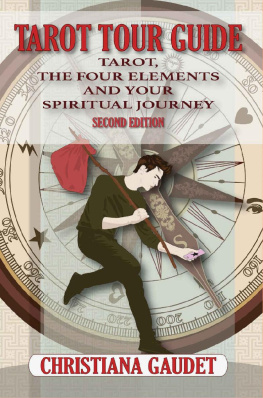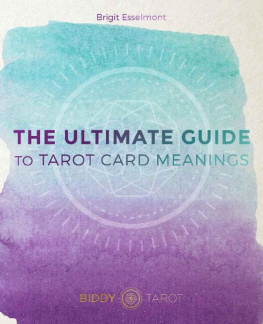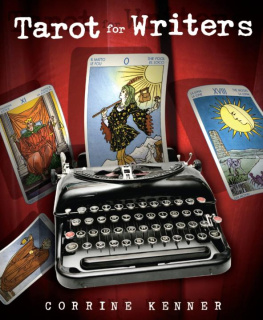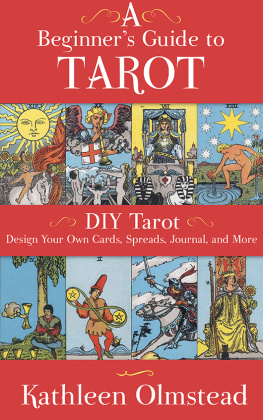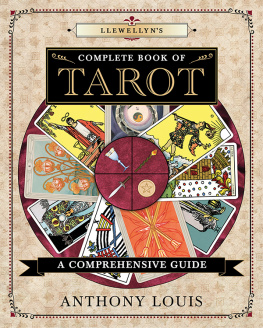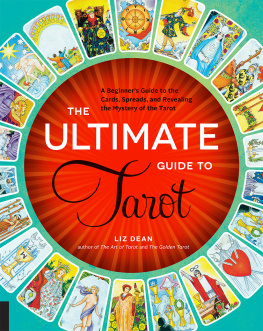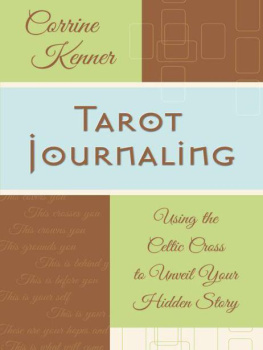Table of Contents

About the Author
Corrine Kenner specializes in bringing metaphysical subjects down to earth. Her work on the tarot is widely published, and her tarot classes and workshops are perennial favorites among students in the Midwest.
Corrine is a certified tarot master, and she has studied tarot under the auspices of the Tarot School of New York, the Wanless Tarot Institute, and Builders of the Adytum. She also holds a bachelors degree in philosophy from California State University, Long Beach.
Corrine has lived in Brazil, Los Angeles, and the Twin Cities of Minnesota. She now lives in the Midwest with her husband, Dan Horon, and her daughters, Katherine, Emily, and Julia. In her everyday life, she is the vice president and communications director of Cadgraphics Incorporated, a software company that specializes in fire alarm and security systems.
Corrine is the author of Llewellyns Tall Dark Stranger , a guide to using tarot cards for romance, as well as Crystals for Beginners . She wrote The Epicurean Tarot , published by U.S. Games Systems, Inc., and she was the creator of Llewellyns Tarot Calendar . A former newspaper reporter and magazine editor, Corrine was also the editor of Llewellyns popular Astrological Calendar , Daily Planetary Guide , and Sun Sign Book , as well as an anthology of supernatural accounts called Strange But True .

Tarot Journaling: Using the Celtic Cross to Unveil Your Hidden Story 2006 by Corrine Kenner. All rights reserved. No part of this book may be used or reproduced in any manner whatsoever, including Internet usage, without written permission from Llewellyn Publications except in the case of brief quotations embodied in critical articles and reviews.
FIRST EDITION
First Printing, 2006
Book design and editing by Rebecca Zins
Cover design by Lisa Novak
Tarot cards on page 90 from Universal Tarot by
Roberto De Angelis; used by permission of Lo Scarabeo
Llewellyn is a registered trademark of Llewellyn Worldwide, Ltd.
Library of Congress Cataloging-in-Publication Data
Kenner, Corrine, 1964-.
Tarot journaling: using the Celtic cross to unveil your hidden story / Corrine Kenner.
1st ed.
p. cm.
Includes bibliographical references (p. ).
ISBN-13: 978-0-7387-0643-6 ISBN-10: 0-7387-0643-4
1. Tarot. 2. DiariesAuthorshipMiscellanea. I. Title.
BF1879.T2K47 2006
133.32424dc22
2005044540
Llewellyn Worldwide does not participate in, endorse, or have any authority or responsibility concerning private business transactions between our authors and the public.
All mail addressed to the author is forwarded but the publisher cannot, unless specifically instructed by the author, give out an address or phone number.
Any Internet references contained in this work are current at publication time, but the publisher cannot guarantee that a specific location will continue to be maintained. Please refer to the publishers website for links to authors websites and other sources.
Llewellyn Publications
A Division of Llewellyn Worldwide, Ltd.
2143 Wooddale Drive, Dept. 0-7387-0643-4
Woodbury, MN 55125-2989
www.llewellyn.com
Printed in the United States of America
Each new day is a blank page in the diary of your life. The secret of success is in turning that diary into the best story you possibly can. DOUGLAS PAGELS
A Cautionary Note
Keeping a tarot journal can be therapeutic, but it isnt therapy. This book was written as a means to help you learn more about yourself, learn more about tarot cards, and have fun. It was not designed to replace the services of a licensed physician or counselor. If you find that the suggestions make you feel uncontrollably weepy, giggly, angry, or outspoken, you may want to seek professional helpor start over with a new journal.
The author and the publisher assume no responsibility for any adverse consequences that may result from the use of this guide, including but not limited to writers cramp, bad handwriting, or a compulsion to buy blank books, tarot decks, and pens.
Dedication
To my old Artists Way group in St. Paul: Karen Failes, Lynn Johnson, Kim Labuz, Linda Nicosia, and especially Mary Lynch.
To my tarot friends from the Readers Studio in New York: Wald and Ruth Ann Amberstone, Kim Arnold, Chris Asselin, Joanna Powell Colbert, Jeffrey Elliott, Mark McElroy, Elinor Greenberg, Carolyn Guss, Debbie Lake, Rachel Nguyen, Kevin Quigley, Gina Thies, James Wells, Diane Wilkes, and especially my roommate, Cheryl Sigler.
To the people who encouraged me and helped teach me how to write: Sister Mary Margaret, my seventh- and eighth-grade English teacher; Sam Johnson, my high school journalism instructor; and Catherine Gaugh, my editor at The Orange County Register .
And of course, to my husband, Dan Horon; my parents, Wayne and Carolyn Kenner; and my daughters, Katherine, Emily, and Julia.
Foreword
Tarot and psychotherapy are becoming more alike every day. Although most of us start tarot because we want to learn the art of divination, after learning the basics many of us turn to the cards in order to learn more about ourselves. Tarot journaling is an outgrowth of that desire. It allows us to use our fascination with the cards as a vehicle for moving beyond our own surface identity into deeper and more hidden parts of our personality.
As a psychotherapist, I often suggest that my clients keep a therapy journal as a way of keeping them involved in the therapy process between sessions. I encourage them to keep track of their dreams, write about their reactions to their therapy sessions, and jot down any new thoughts and observations that they would like to discuss. Eventually it becomes an emotional autobiography that chronicles their deepest and most personal reactions to their everyday life.
One of the interesting facts about these journals is that many of my clients who successfully keep therapy journals had previously seen themselves as writing failures. Some even had writing phobias that interfered with them turning in papers in college. I could identify with these problems because I had experienced similar difficulties during college myself.
Despite my later success in keeping dream and tarot journals, I initially made a number of failed attempts at keeping a diary. When faced with a blank page and the mission of saying something important about my life on a daily basis, I could not do it. I found it too difficult to access my feelings and get beyond keeping a superficial record of my daily activities. I also was inhibited by my fear that if I wrote truthfully, my parents, roommate, or boyfriend of the time would peek.
As I tried to understand what had changed for my clients and myself that allowed us to keep dream and therapy journals successfully, I realized that the nature of these journals frees us from three things that often get in the way: one, we no longer had to decide what to write about; two, the assigned theme helps us organize our thoughts; and three, we know that the quality of our writing will not be judgedwe can jot down a few ideas, write endless run-on sentences, and it does not matter.
Tarot journals share exactly the same virtues. The tarot journal revolves around tarot cards: what they mean, what they look like, our reactions to them, and exercises involving them. This saves us from looking at a blank page and wondering what to write about. In addition, we know from the beginning that the journal is for ourselves and, as Corrine makes abundantly clear in this book, we are free to do anything that we wish with it. We can write in it every day or only occasionally. It can be decorated or plain. There is no right way or wrong way of doing it. What this means is that tarot journals, in addition to teaching the tarot enthusiast more about tarot, allow many of us to experience for the first time the pleasures of journaling.
Next page
